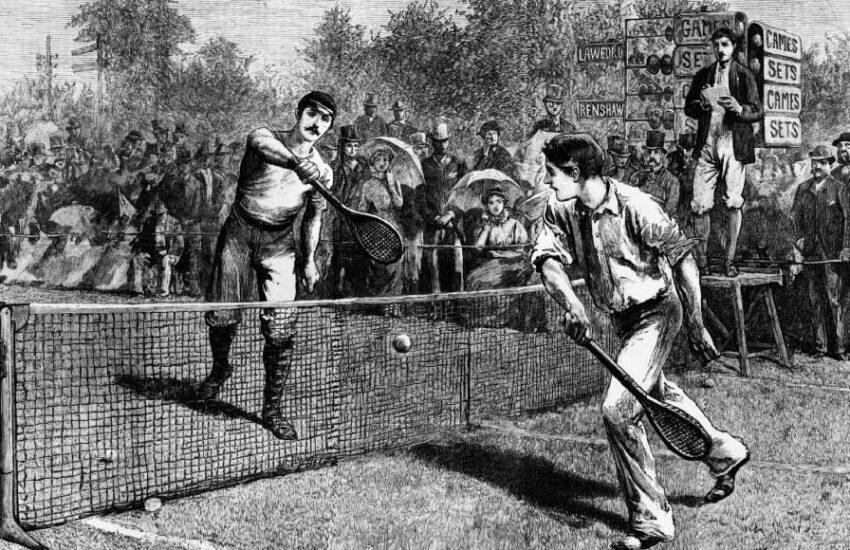Tapestry of Tennis: From Medieval Origins to Modern
Tennis, with its enigmatic historical roots, is believed to have originated in France between the 11th and 12th centuries, known initially as ‘jeu de paume’ or ‘game of the palm.’ This early version of tennis was more than a mere sport; it was a reflection of the societal and cultural milieu of medieval France. Nobles and commoners alike found enjoyment in the game, which was played in courtyards and cloisters. This period laid the foundational ethos of tennis, combining physical skill with social interaction, a characteristic that endures in the sport to this day.
Transition from Hand Game to Racket Sport
The evolution from playing with the palm to using rackets was a significant milestone in the history of tennis. This transition, occurring over several centuries, represented a technological and strategic advancement in the game. The introduction of rackets brought about a new dimension of skill and tactics, as players could now impart different spins and speeds to the ball. This change also signified the sport’s shift from a leisurely pastime to a more structured and competitive pursuit, laying the groundwork for the rules and formats that would later define modern tennis.
Tennis’ Transformation into a Modern Sport
By the late 19th century, tennis had evolved considerably from its French origins, spreading across Europe and undergoing several modifications. These changes were not just in equipment and playstyle, but also in the structure and organization of the game. Tennis began to be recognized as a formal sport, with codified rules and organized competitions. This era marked the transition from a recreational activity to an established sport, setting the stage for the international competitions and professional circuits that would emerge in the following years.
Major Walter Clopton Wingfield: Architect of Modern Tennis
Major Walter Clopton Wingfield is a seminal figure in tennis history, credited with patenting ‘Sphairistike’ in 1874, which closely resembled the modern game. His version of tennis, played on a rectangular court with a net, is the direct precursor to today’s game. Wingfield’s contribution was not just in the gameplay, but also in popularizing the sport, making it accessible and enjoyable for a wider audience. His vision and innovation played a crucial role in transforming tennis from a pastime into a globally recognized sport.
Tennis in the Contemporary World: A Global Phenomenon
Today, tennis stands as a testament to its enduring appeal, with major tournaments like the Australian Open, French Open, Wimbledon, and U.S. Open drawing global attention. The sport has transcended its historical roots to become a symbol of athleticism, competition, and international camaraderie. Tennis players from diverse backgrounds have brought their unique styles and narratives to the game, enriching its history and appealing to a broad audience worldwide.
Major Wingfield: A Versatile Visionary
Major Walter Clopton Wingfield’s legacy extends beyond tennis. His contributions to military aviation, particularly his design for a military helicopter, underscore his versatile genius. Wingfield’s multifaceted career, spanning sports and military innovation, positions him as a visionary who significantly impacted various fields. Remembering his diverse achievements provides a holistic understanding of the man often referred to as the father of modern tennis.
Engaging with Tennis History and Learning
For enthusiasts looking to delve deeper into tennis, exploring its history and nuances can be a rewarding journey. Tennis instructors and experts in Mountlake Terrace, WA, offer insights into the sport’s strategies, techniques, and historical context. Engaging with professionals or sharing thoughts through comments can enhance one’s understanding and appreciation of tennis, connecting traditions with current practices.
Comparative Table: Evolution of Tennis Over Centuries
| Era | Description | Key Developments |
|---|---|---|
| 11th-12th Century France | ‘Jeu de paume’ played with the palm | Social sport among nobles and commoners |
| Transition to Rackets | Introduction of rackets in the game | Strategic and technological advancement |
| Late 19th Century | Formalization and spread of tennis | Codification of rules, structured competitions |
| Major Walter Wingfield’s Era | Patenting of ‘Sphairistike’ | Foundation for modern tennis |
| Contemporary Tennis | Global tournaments, diverse players | Symbol of athleticism, international recognition |
Key Milestones in Tennis History
- 11th-12th Century: Tennis originates in France as ‘jeu de paume.’;
- Renaissance: Adaptation from hand to racket play;
- Late 19th Century: Formalization and spread of the game across Europe;
- 1874: Major Walter Clopton Wingfield patents ‘Sphairistike.’;
- 1877: The first Wimbledon tournament is held;
- 20th Century Onward: Evolution into a global sport with major international tournaments.
Conclusion
Tennis, from its medieval French beginnings to its current status as a global sport, demonstrates a remarkable journey of evolution and adaptation. The contributions of figures like Major Walter Clopton Wingfield have been instrumental in shaping the sport. Today, tennis continues to captivate audiences worldwide, offering a unique blend of athletic prowess, strategic complexity, and cultural significance. Its rich history and ongoing evolution underscore the timeless allure of this beloved sport.



